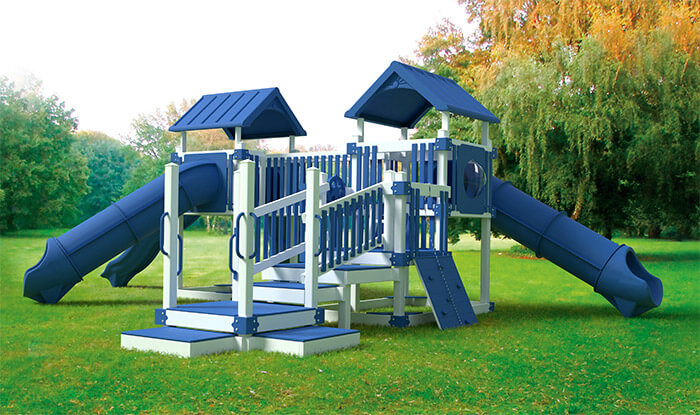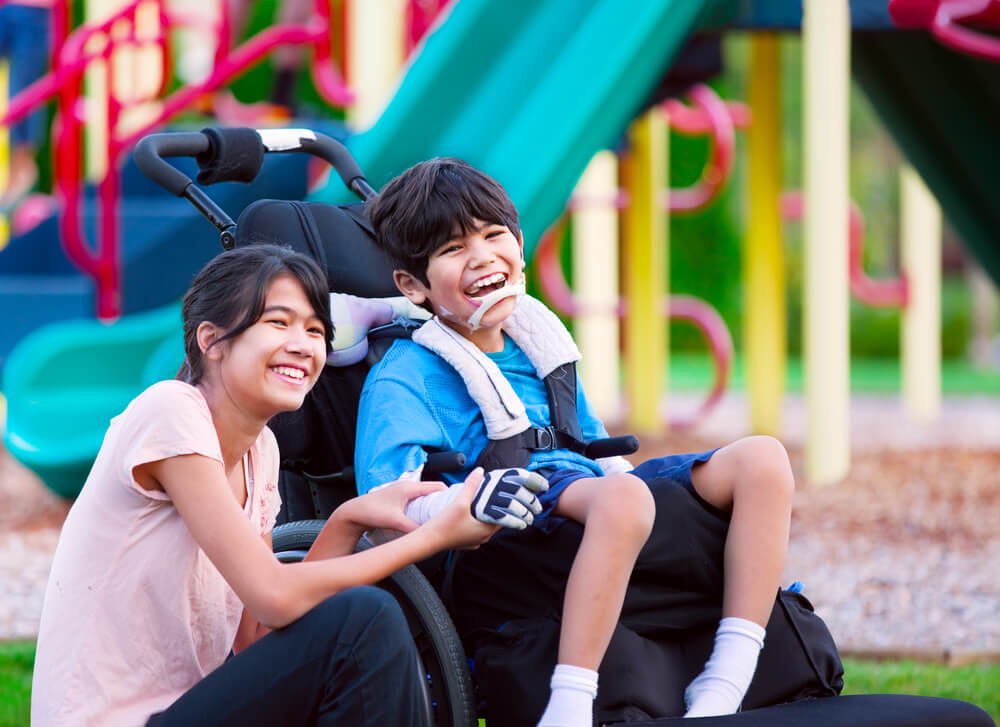All children have a desire to play, but for them, it’s so much more than simply having fun. Maybe you’ve heard the famous quote from Jean Piaget: “Play is the work of childhood.” Studies show that kids need play for their cognitive, physical, and social development.
As parents and caretakers, it’s crucial that we recognize the impact play has on development. And if your facility is looking to buy a commercial playset, it must be accessible for children of all abilities. Learn how to make your playground ADA-compliant to create an inclusive space for all children to play together.
What the Americans with Disabilities Act (ADA) Says
The Americans with Disabilities Act (ADA) was passed in 1990 to ensure people with disabilities have equal rights. It outlawed discrimination against people with disabilities in their jobs, schools, transportation, and all places open to the public.
In 2010, the Department of Justice put new laws in place that required all newly built and altered recreational facilities, including playgrounds and play areas, to comply with the ADA. If your public facility has a commercial playground, it must be compliant.
What Makes a Playground ADA Compliant?
According to the 2010 ADA Standards for Accessible Design, ADA playgrounds must include a number of specific accessible play components, routes, and play surfaces to qualify as compliant.
Play Components
A play component is any element of the playground designed to encourage socialization or learning. They can be stand-alone items or they can be elements built directly into the playground’s structure.
There are two classifications of play components: ground-level and elevated. These are what they imply; ground-level play components are accessed from ground level, and elevated components are accessed above or below grade. Both must exist on your ADA playground.
Every play component offers a different “type” of play experience. They are categorized by some of the following activities:
- Rocking
- Swinging
- Climbing
- Spinning
- Sliding
To make your playground ADA accessible for children with disabilities, your play area is required to have a minimum number of ground-level components, along with a minimum number of different types of ground-level components. This number will depend on the amount of elevated play components built onto your playground.
Accessible Routes
After you figure out how many ground-level and elevated play components you’re going to use in your play area, you must determine the number of accessible routes required to meet playground ADA compliance.
An accessible route is an unobstructed path that allows individuals with disabilities, specifically wheelchair users or those who walk with mobility aids, to easily move throughout the play area.
These routes apply inside and outside of the boundaries of play areas. Externally, the ADA requires a clear path from the commercial facility’s parking lot or building to the playground area. Internally, it requires a clear path that connects the entry and exit points of the accessible play components.
Just like play components, there are 2 types of accessible routes — ground-level and elevated. They rely on three requirements: location, clear width, and slope.
Ground-level accessible routes connect the ground play components and create a path for wheelchair users to move throughout the play area. They must have a minimum clear width of 60 inches so that 2 wheelchairs can use the route and change directions at the same time.
The maximum slope allowed for a ground-level accessible route is 1:16 degrees.
An elevated accessible route connects the elevated play components to each other and to the composite structure. These routes must be connected to 50% of the play area’s entry and exit points. Two ways to do that are ramps and transfer systems.
Transfer systems create a space for children to move up and down the composite structure without the use of their wheelchairs or mobility devices. They usually consist of a transfer platform, transfer steps, and transfer supports.
- Transfer platforms: a landing where wheelchair users can lift themselves onto the play structure leaving their wheelchair on the ground.
- Transfer steps: the steps that lead from the transfer platform to the composite structure.
- Transfer supports: handrails, grips, or handholds that children with physical disabilities can use to move onto the platform and up the steps. They must be on elevated accessible routes where transfer systems are the access method.

Transfer systems are a good way to create access to elevated surfaces for children who are comfortable leaving their mobility devices on the ground. However, not all children are going to be able to or want to use a transfer system.
According to the ADA, the recommended method of access for elevated routes is ramps. Ramps provide access to elevated play components for children without having to transfer from their wheelchairs.
The minimum clear width of ramps must be 36 inches and the maximum slope is 1:12 degrees. In addition, handrails are required to protect mobility device users from falling from the elevated route.
In general, the amount of ground-level accessibility routes will depend on the number of elevated play components built into your play area. Using this chart, you can determine how many accessible routes are required for your ADA playground.
Elevated accessibility routes must connect at least 50% of your play components. Transfer systems can be used if your commercial playset has less than 20 elevated play components. If your playset has more than 20 components, ramps must account for at least 25% of the 50% of elevated accessibility routes required.
Play Surfaces
Perhaps the most important factor in designing your ADA-compliant playground is choosing the play area’s surface material. The type of material that you choose to use under your play area can make all the difference in promoting inclusive play.
If the surface material is inaccessible for children who use mobility devices, they’ll exert so much energy navigating the play area that they have little left to play. As of now, there is no perfect playground surface, but there are a few that can increase the ease of movement.
Poured-in-Place Rubber (PIP) is one of the safest play surface materials because it is non-splintering and durable. It is a common choice for ADA playsets because its smooth surface makes wheeling easy.
Its most common accessibility complaint is that cracking and flaking can occur over time leading to divots along the surface. This poses a safety hazard for wheelchair users and must be repaired by a trained installer to keep the playground surface compliant.

Rubber Tiles are similar to PIP because they’re both made of rubber. Tiles, however, are multiple pieces of rubber bonded together as opposed to a single layer that’s poured in place.
As normal wear and tear runs its course, dirt and other debris can build up between the seams, creating separation between the tiles. This can complicate the ease of movement for children who use a mobility device because it creates an uneven surface.
Engineered Wood Fiber (EWF) is made from pieces of wood ground into a fibrous consistency. As opposed to the rubber surfaces which are unitary surfaces, EWF is a loose filled surface. This means as children move across the play surface, the pieces will shift causing a change in surface level.
To combat this issue, the ADA recommends that EWF is installed in layers and compacted down to reduce the amount of displaced material.
Synthetic Turf looks like grass, but is better cushioned, slip resistant, and level than a natural grass surface. It’s quite easy to maintain, but it can be difficult and expensive to install.
The smooth surface makes it one of the best choices for an ADA-compliant playground. There’s no risk of displaced materials, gaps, or divots — there’s no surprise that it’s one of the fastest-growing play surface materials!
Until more longitudinal studies are conducted, these are the 4 types of ADA-compliant surfaces that we suggest. Keep in mind, the play surface material you choose must also meet the ASTM standards in order to be ADA compliant.
ADA Playground Checklist
Routine maintenance will be required to make sure your playground continues to comply. If you’re looking for a condensed list of items to monitor, this ADA playground checklist is a good starting point. For a more detailed description, you should refer to Chapter 10 of the U.S. Access Board.
- Does your playground have an accessible route to the play area that’s at least 60 inches wide?
- Does your play surface comply with the ASTM, and is the surface free of divots or deterioration?
- Do you meet the requirement for the minimum number of ground play components? (Refer to the chart above to determine this number.)
- Are there accessible routes that connect the entry and exit points of each type of ground-level play component?
- Do elevated accessible routes connect at least 50% of your elevated play components?
- If you have more than 20 play components — are at least 25% of those routes connected by ramps?
- Are there handrails on both sides of the ramp?
All children have the right to play. At a minimum, these are the requirements to meet playground ADA compliance. If you’d like to take your playground a step further than compliance, learn how to design an inclusive playground community.

